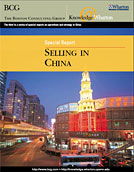Multinational companies hoping to access China’s 1.3 billion consumers face a number of challenges, not the least of which is figuring out how they can market products to a culture that includes poor rural farmers along with urban multi-millionaires, with a range of unique, localized buying preferences and behaviors in between. Because it is so difficult to generalize about Chinese consumers, global “one-size-fits-all” marketing strategies seem destined to fail.
Knowledge at Wharton spoke with Deepak Advani, senior vice president and chief marketing officer of computer manufacturer Lenovo, and Hal Sirkin, senior vice president of BCG and leader of the firm’s Global Operations Practice, about strategies for selling to Chinese consumers. The key, they point out, is to tailor products and messages to local markets. They also discuss where consumer growth is taking place, brand perception, and why selling goods and services to China isn’t so different from selling to China’s neighbor and rival, India.
Knowledge at Wharton: Treasure Hunt, a book written by Michael J. Silverstein, Hal’s colleague at BCG, makes the point that all around the world, consumers seem to be converging at two pools. One is at the high end of the market, where people are trading up. But there is also a real drive for value, so people want discounted products as well. This means that there is a dent in the middle — and this middle ground of the market is shrinking. Deepak and Hal, are you seeing this in China?
Advani: Yes, I think that’s true around the world — we have customers who are looking for value and a bargain price, and others who are seeking a premium branded product. What we’ve seen in China, though, and what’s more relevant to us, is whether they’re relationship-driven or transaction-driven customers. Segmenting the market into these two categories is more useful because these two types of customers have very different needs.
Over the last couple of years, we’ve created an end-to-end value chain for transactional and relationship customers that enables us not only to build the products, but also take them to market, and that includes the routes, the sales, the marketing — all of which is oriented toward relationship or transactional customers. Our product line includes premium products that are at the higher end of the spectrum, as well as products that are aimed at the cost-conscious or value buyer.
Knowledge at Wharton: Hal, you work with a number of companies in China. Do you see a shrinking middle ground?
Sirkin: Yes. The segmentation in China matches what we’re seeing in the West: One segment wants premium products, and another is very cost conscious. A good industry to look at besides the computer business is the automotive business. There are very premium cars and lower-end, entry-level cars sold in China — and not much in between. This may change, but right now we’re seeing those two ends of the cost spectrum.
Knowledge at Wharton: Apart from the computer and auto industries, could you give any examples of companies that are doing a good job of selling into China? Which companies have gotten China right, and why?
Sirkin: Some consumer product companies have done an excellent job selling products such as health and beauty aids. They’ve done a very good job at segmenting the market, creating both low-end, single-use products and high-end luxury goods that you’d see on Rodeo Drive or the Champs-Elysees.
For health and beauty aids and cosmetics, the segmentation is more extreme than in most Western countries, because companies are offering products at the very low end of the price scale.
Advani: In the PC space, we have a fairly dominant market share in China, hovering around 38%, and one thing we’re seeing — and doing ourselves — is partnering with other companies. We’ve partnered with companies like Oak and Disney very effectively. And to give credit to these other companies, their strategies to succeed in China are very localized. They don’t take a global marketing campaign or marketing playbook and just execute in China; they really factor in the needs of Chinese consumers and present their value proposition in localized terms. And that I see as one of the key success factors in China.
Knowledge at Wharton: To turn the question around a little bit, what are some of the most common mistakes you have found companies make when they try to enter China to sell to Chinese consumers? You mentioned the problem of trying to apply the global mindset, without trying to localize, but are there other common mistakes?
Advani: There are a few. One important lesson is to be in it for the long run. You can’t expect miracles overnight and expect to become a player in China by having a short-term mindset. You need patience and a sustainable long-term strategy to grow.
As I mentioned earlier, having a localized mindset is critical, and very broad. It’s not just about marketing, but also your overall strategy in China. Many multinational companies take globally designed products to China and market them using global campaigns and marketing channels. As in India, the bulk of opportunities for selling PCs — and consumer electronics, cars and the like — in China are in the four or five largest cities — Beijing, Shanghai and so forth. Capturing market share there doesn’t require you to have very localized, customized products and go-to-market strategies.
But most of the growth right now and over the next four to five years will be in the tier five and tier six cities. These are smaller cities, and if you are approaching them with global strategies, global products and global go-to-market, it becomes very difficult to penetrate because the needs of this type of consumer are very different. You need to develop products that appeal to them, that factor in their local tastes; you need to speak to them with messaging that is relevant to them. You need channels that are more accessible to them — like storefronts, which are very popular in China. So you need a very localized strategy if you want to grow in these high-growth areas.
Sirkin: To build on Deepak’s point, companies that are relatively new to China often miss the importance of the distribution system, particularly outside of the four or five big cities. You can’t do it yourself in the smaller cities; you need distribution partners. The logistics are very different and much more difficult than in most of the more developed countries. These smaller cities are rapidly developing, but they’re still very much in the development mode. So getting a product to market — not just the right product, but any product — without the right distribution system can be a nightmare.
Knowledge at Wharton: How do distribution issues interfere with or impact brand-building efforts? Deepak, maybe you could start by addressing that from Lenovo’s perspective.
Advani: The distribution networks you have in place can be a very effective way to build your brand. As an example, you sell directly to many of your relationship-type customers, face-to-face. Yet many of the transaction-type customers are in the tier five and tier six cities, and store fronts are the way to reach these consumers. We have 4,000 to 5,000 retail store fronts all across China. This enables us to build our brand in a very direct way, because there are many tactics we can use to convey our brand’s value proposition. The best way to build your brand is to have people touch and feel your product. That’s what Apple does so well in the United States, and that’s what we do in China.
Knowledge at Wharton: Hal, based on your experience with companies outside of China, how do they begin to figure out or break into the distribution system in China to make this kind of store front situation possible?
Sirkin: It’s very hard. You’ve got to begin in the major cities and start building the contacts, which often come from working with other companies. But as Deepak pointed out, it’s all very, very local. So you have to bring people on board who understand the local conditions almost market by market.
Advani: Yes, that is exactly right. Many companies start out in the larger cities, which feel, look and act much more like developed markets. But in the tier five and tier six cities, where most of the exciting market growth is, you need a very good understanding of how things work.
For instance, in some of those smaller cities, there are little malls where a vendor may have five store fronts on the same floor. To a western multinational company, that might seem a complete waste of effort and resources; but that’s what it takes to grow, that’s the way the psyche works.
Also, the point that was made — that a lot of it is relationships — is spot on. You need to build a network of distributors that you’ve gotten to know and trust over time. If they see that you are in it for the long run, through patience and sustained efforts you build those relationships over time.
Knowledge at Wharton: It sounds like there’s a big effort to push for the tier five and tier six cities now. Deepak, what is the likelihood of a non-urban Chinese citizen owning a computer in, say, five years, or maybe even ten years? What do you predict the penetration will be outside the urban areas of China, where the wealth seems to be concentrated?
Advani: The growth is absolutely tremendous. One of the reasons why China is such an attractive market is the fast-growing middle class with huge purchasing power. Also, we’ve been working with a lot of our partners to bring value propositions that are very attractive and affordable. We just announced a program with Microsoft that enables consumers to ‘pay as you go’ for a PC, which significantly reduces the upfront cost of acquisition and allows you to pay for your PC over time. Other companies are focusing on the $100 PC and the like.
China values education quite a bit. Families spend a disproportionate amount of their disposable income on education. So we also focus a lot on innovating to make desktops, for instance, much more multi-user friendly, particularly for schools with very few IT skills. We design technology that enables people to share a computer very effectively.
Companies like Lenovo, Microsoft, and Intel are focused on making the PC more affordable. The Internet is penetrating quickly as well, which makes the PC much more useful. Schools, universities and some of the smaller towns have a strong interest in breaking technology. So the future looks extremely bright for penetration in some of the non-urban areas.
Knowledge at Wharton: Is education a big thrust of the marketing campaign to get computers out to families in that market?
Advani: Absolutely. In fact, we have a product line that’s been designed for the education space, with specific features that we came up with when we did our market research.
In a lot of the schools, especially in small towns, there isn’t much IT capability, but there is a desire that multiple students share a desktop PC. We designed a very simple hardware and software solution, a little button that looks like a power button. After a student is done working on the computer, they may have moved around some desktop icons or even deleted some files; by pressing that one button, in less than a minute everything gets re-set exactly to the way the system was before the student started to work on it. This allows [teachers] to get the PC somewhat pristine for the next user.
So, having a product line for the education space is definitely a focus for us.
Knowledge at Wharton: Hal, how do other forms of electronics penetrate that market?
Sirkin: It’s critical to meet the local needs. How do I make it affordable? What payment options can I offer? We’re seeing more and more pay-as-you-go plans, where the manufacturers finance items over time. And we’re seeing this in India, Mexico and many different places, not just China.
In these markets, the credit systems aren’t well developed, so sellers need to create financing mechanisms designed for less developed or rapidly developing economies. This is especially true for higher-cost products such as appliances.
Knowledge at Wharton: What product qualities are most attractive to middle-class consumers in China, specifically in terms of electronics? Is quality a key issue, or are there other considerations that middle class buyers tend to have for these kinds of products?
Advani: Although price is clearly a factor, one thing that is somewhat counterintuitive is the importance of brand, particularly in China and India, whose purchasing power is increasing. For the first time, people can afford a car, a TV or a computer, and the brand that they buy is really a reflection of their place in society.
When you interview focus groups or talk to consumers one-on-one, you find a greater appreciation for savings. They want to buy something of good quality, something that will last a while. Brand is very important and relevant, both from a practical perspective of ‘I want this thing to last,’ and from an emotional perspective as a reflection of a consumer’s place in society.
Sirkin: To build on that, Chinese consumers are value buyers, not price buyers. They look at the value/price relationship and won’t necessarily buy the lowest-cost item if it won’t last long or isn’t of good quality. They’re informed buyers, and they look at value.
At the same time, some goods in China have the same strong brand value and prestige that we see in the most rapidly developing economies. So quality and prestige are both important aspects of brand in China, but we see a lot of value buying rather than price buying.
Knowledge at Wharton: Both of you mentioned some of the similarities between buying behavior in China and in India. I was wondering if you see differences as well. Are there any ways in which Chinese and Indians buy things differently, because these are the two big markets that most of the world seems to be looking at so closely right now.
Advani: Our experience has been that there are quite a few similarities. In fact, we are in the process of replicating our China business model and go-to-market strategy in India, with very much an Indian flavor. As with China, in India there’s a lot of opportunities in the larger cities, but the growth is much stronger in the smaller cities. Also, the importance of education to Indian families is just as high as it is in China.
In India, PC security is more about theft than embedded fingerprint reader encryption subsystems. When people buy a PC, they don’t want to lose it. Instead of talking about why you need to upgrade your PC, your messages have to be about why the PC is a good thing, because penetration is down to 1%. You have a lot of first-time buyers. So the low penetration rate, growth in the smaller cities, a lot of first time buyers, the importance of education, the need to speak to consumers in a local language instead of a global language — all these things are common.
In India, we have signed up local celebrities to be our brand ambassadors, so that the messages we are conveying will resonate much more with the Indian consumer. In China we have 5,000 store fronts, but we have fewer — over 100 — in India. In India, the way you go to market with your channel partners is slightly different. In China we have an exclusive distribution network that sells only our products. In India, often you have store fronts that are not exclusive to you, and you’ll have other vendors profiled there as well. So there are some differences, but if I step back and look at the macro view, there are a lot more similarities than there are differences as far as how you market, at least in the PC space.
Sirkin: I would agree that there are a lot of similarities. It comes down to local tailoring to different tastes, and different ways of presenting things — minor differences. But the macro pictures are very similar. These are both markets with a billion people, with very large potential. The companies that succeed will have the ability to look at each market from a macro perspective, and then tailor it from a micro perspective.



